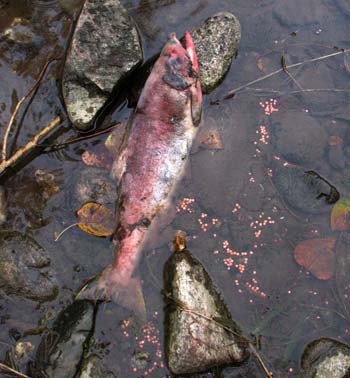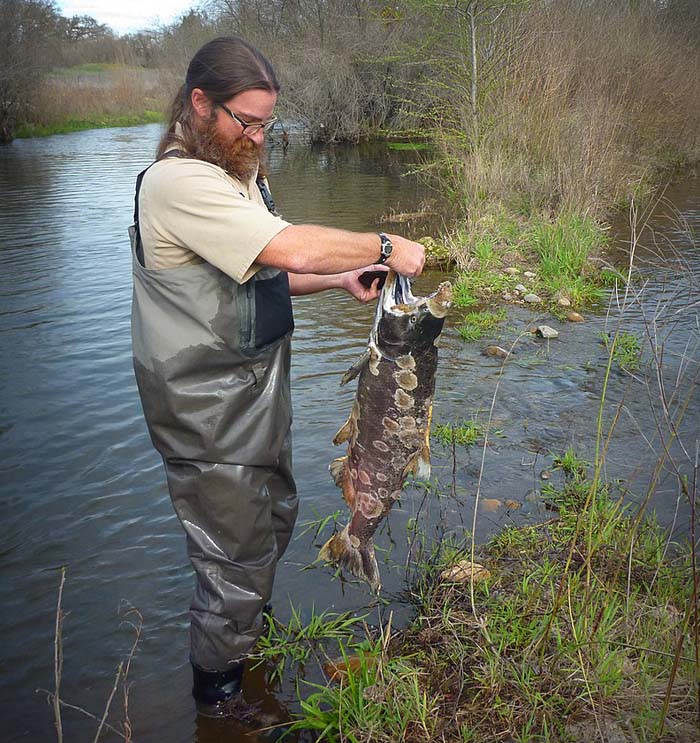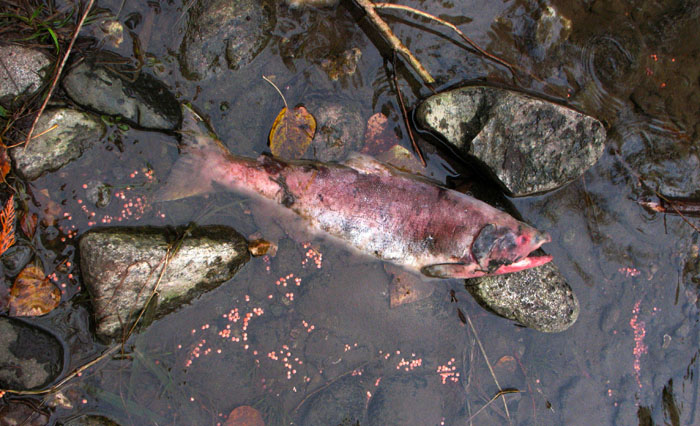by Frances Backhouse / Hakai Magazine / June 1, 2017
Chucking chum and coho carcasses into a salmon-spawning stream supports more than just an ecosystem.

A sockeye salmon carcass and salmon eggs, Adams River, British Columbia. Photo by Peter Sircom Bromley – a commons image.
[dropcap]O[/dropcap]n a chilly January morning, four-year-old Eli Burger stands on the bank of Douglas Creek, on the outskirts of Victoria, British Columbia, hugging a dead salmon half as long as him against his red parka. He looks up at his father, Andrew Burger, who nods encouragingly. “Go ahead,” he says, “chuck it in.” Eli shuffles forward until his blue rubber boots touch the edge of the creek and heaves the fish as far as he can into the shallow water. It lands with a splash and drifts for a moment before settling against a boulder. “It’s floating!” Eli exclaims, his delight in the salmon’s buoyancy eliciting smiles from several nearby adults. For a moment, it’s almost as if the handsome coho could wriggle back to life.
Eli’s salmon is just one of 100 or so chum and coho carcasses that will land in Douglas Creek in a half-hour frenzy of activity this morning—lobbed, pitched, flung, plunked, or otherwise deposited by dozens of volunteers of all ages under the watchful eye of Darrell Wick, the man who has convened this gathering. None of the salmon will miraculously rise from the dead, but Wick is in the resurrection business.
Cofounder and president of the Friends of Mount Douglas Park Society, Wick also leads the group’s campaign to re-establish this urban waterway’s salmon population. The drive for river restoration in cities worldwide began a few decades ago with some high-profile results: in 2005, Seoul, South Korea, liberated a five-kilometer ribbon of water by demolishing a highway; and Los Angeles, California, has a specialized team within the mayor’s office whose sole job is rejuvenating the Los Angeles River, a process that began in 2002. But smaller communities with smaller waterways and a handful of volunteers have been just as diligent. The Friends of Mount Douglas began investigating the possibility of restoring the salmon run in their little stub of a creek in the mid-1990s.

Fish biologist Jimmy Faukner from the Stockton Fish and Wildlife Office inspects the carcass of a Chinook salmon (Oncorhynchus tshawytscha) recovered from the Tuolumne River, California to determine if it is of hatchery origin. Photo USFWS.
The prospects looked bleak
Time has been unkind to Douglas Creek, which flows down the flanks of Mount Douglas—also known as PKOLS in the SENĆOŦEN language—and empties into the Salish Sea off southern Vancouver Island. Over the past eight generations, much of the creek’s 5.6-square-kilometer watershed (Vancouver’s Stanley Park is about four square kilometers) has been transformed from forest to farmland to suburbia. The upper reaches are now entombed in underground culverts and only the final 1.1-kilometer stretch, which lies within the forested enclave of Mount Douglas Park, ever sees daylight. Even this remnant has suffered much abuse. Pollution from roads, lawns, and residential oil tank spills is now largely curtailed, thanks to municipal regulations and the construction of a weir and settling pond at the head of the creek. But storm surges fed by runoff from paved surfaces and roofs still threaten the creek’s integrity, eroding its banks and scouring the channel.
Biologist Peter McCully helped assess the waterway’s potential. “We did a pretty significant inventory,” he says, “and the only thing we found was a scud,” a notably hardy little crustacean. “We didn’t turn up any fin fish, any amphibians, nothing.”
Most people would have given up at that point. The Friends of Mount Douglas simply got to work—


